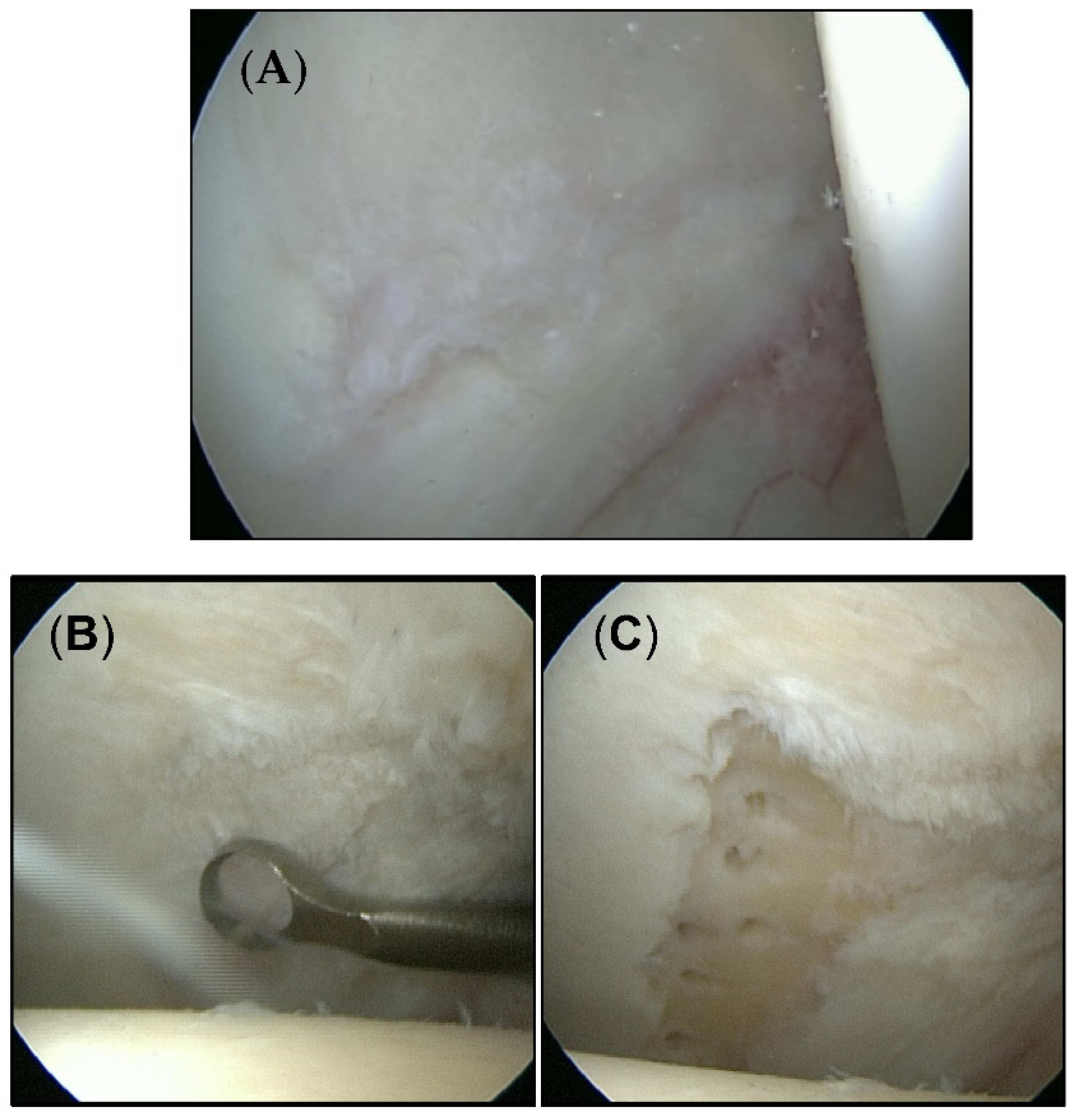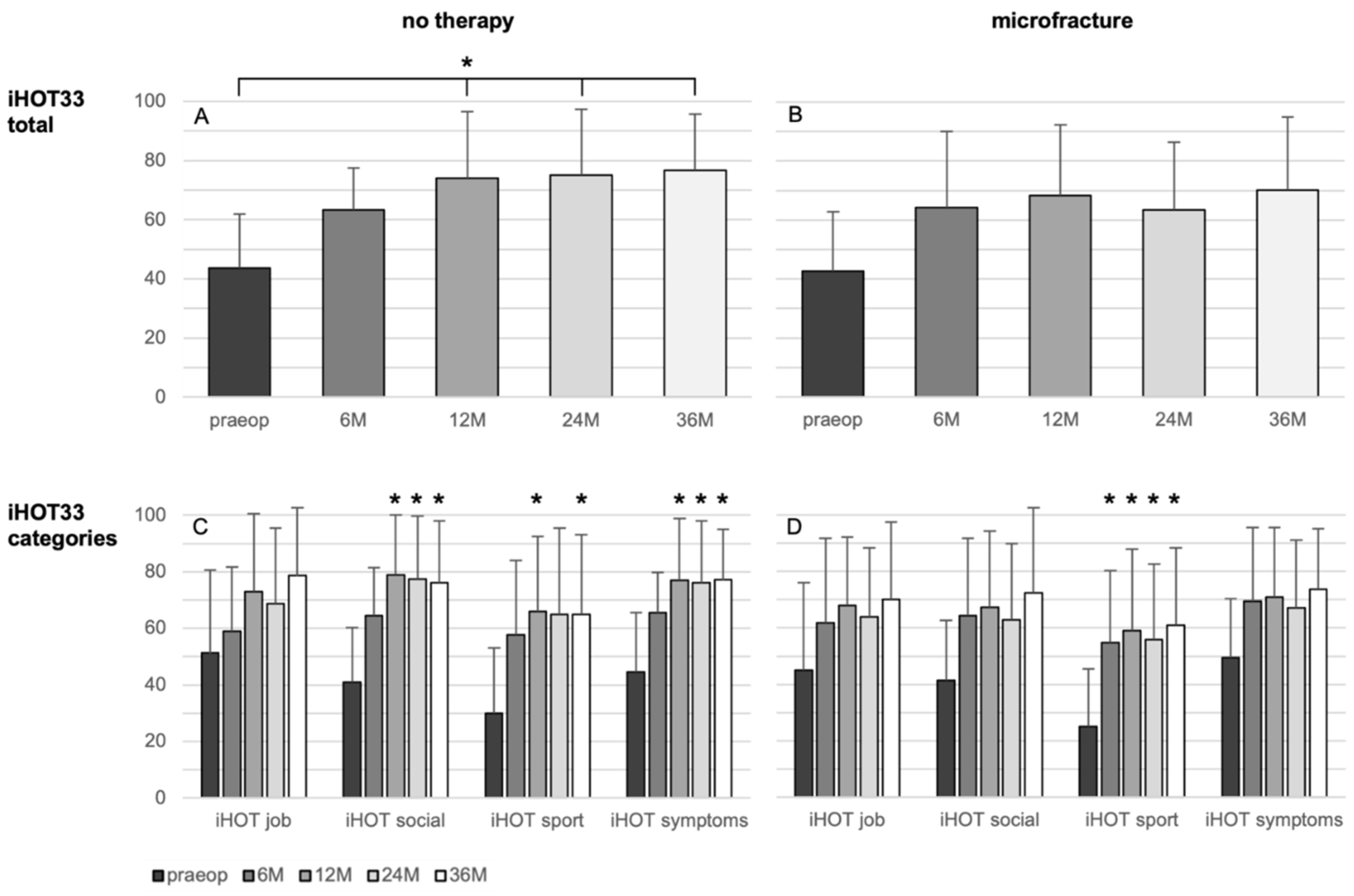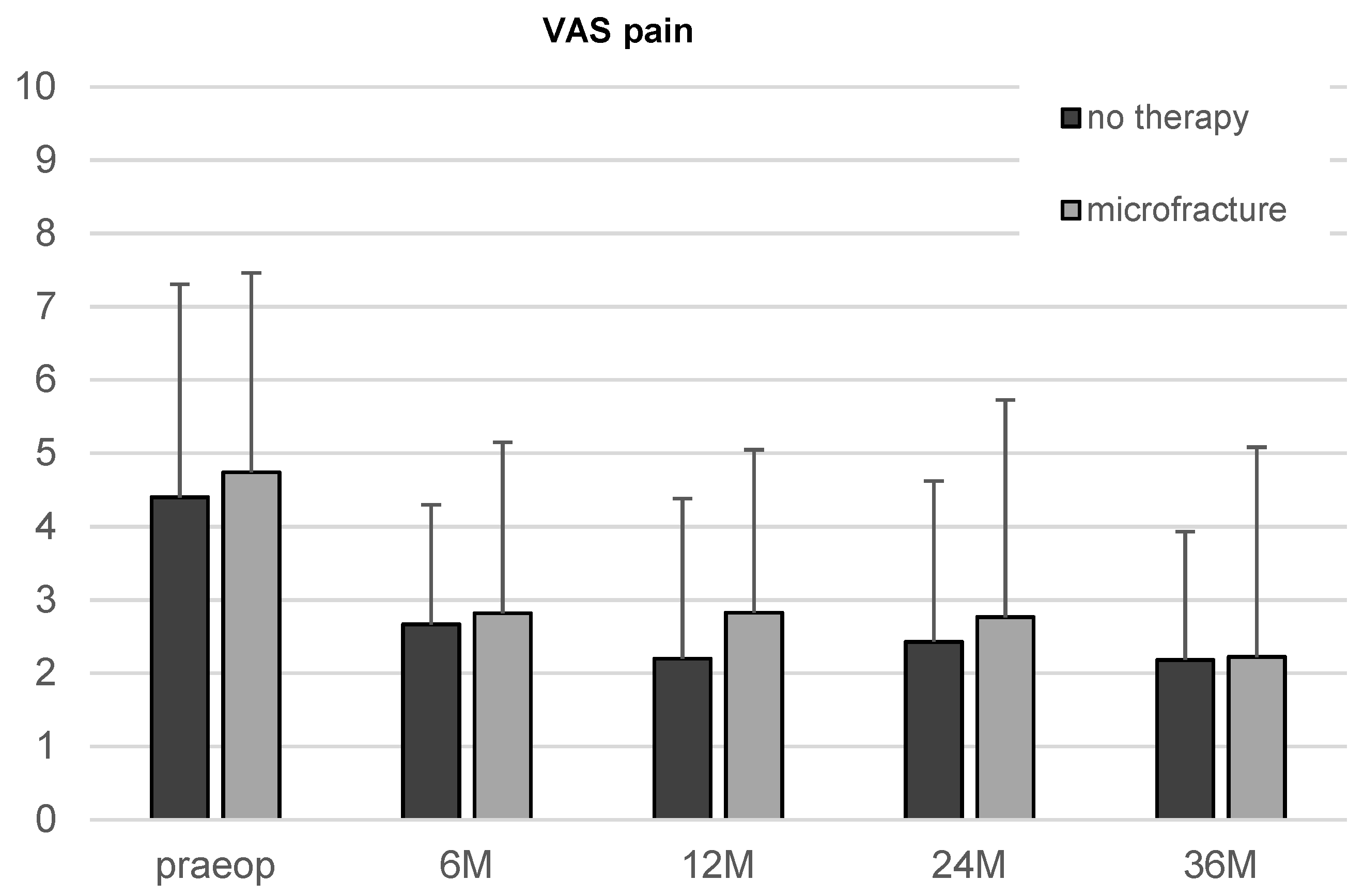Patients with Small Acetabular Cartilage Defects Caused by Femoroacetabular Impingement Do Not Benefit from Microfracture
Abstract
1. Introduction
2. Methods
2.1. Protocol Design and Patient Cohort
2.2. Surgical Technique
2.3. Rehabilitation Protocol
2.4. Psychometric Analysis
2.5. Statistical Analysis
3. Results
4. Discussion
5. Conclusions
Author Contributions
Funding
Institutional Review Board Statement
Informed Consent Statement
Data Availability Statement
Conflicts of Interest
References
- Ganz, R.; Leunig, M.; Leunig-Ganz, K.; Harris, W.H. The etiology of osteoarthritis of the hip: An integrated mechanical concept. Clin. Orthop. Relat. Res. 2008, 466, 264. [Google Scholar] [CrossRef] [PubMed]
- Ganz, R.; Parvizi, J.; Beck, M.; Leunig, M.; Nötzli, H.; Siebenrock, K.A. Femoroacetabular impingement: A cause for osteoarthritis of the hip. Clin. Orthop. Relat. Res. 2003, 417, 112–120. [Google Scholar] [CrossRef] [PubMed]
- Ross, J.R.; Larson, C.M.; Bedi, A. Indications for Hip Arthroscopy. Sport. Health 2017, 9, 402–413. [Google Scholar] [CrossRef] [PubMed]
- Dallich, A.A.; Rath, E.; Atzmon, R.; Radparvar, J.R.; Fontana, A.; Sharfman, Z.; Amar, E. Chondral lesions in the hip: A review of relevant anatomy, imaging and treatment modalities. J. Hip Preserv. Surg. 2019, 6, 3–15. [Google Scholar] [CrossRef] [PubMed]
- Jannelli, E.; Fontana, A. Arthroscopic treatment of chondral defects in the hip: AMIC, MACI, microfragmented adipose tissue transplantation (MATT) and other options. SICOT-J 2017, 3, 43. [Google Scholar] [CrossRef] [PubMed]
- Karthikeyan, S.; Roberts, S.; Griffin, D. Microfracture for Acetabular Chondral Defects in Patients with Femoroacetabular Impingement: Results at Second-Look Arthroscopic Surgery. Am. J. Sport. Med. 2012, 40, 2725–2730. [Google Scholar] [CrossRef]
- Marquez-Lara, A.; Mannava, S.; Howse, E.A.; Stone, A.V.; Stubbs, A.J. Arthroscopic Management of Hip Chondral Defects: A Systematic Review of the Literature. Arthrosc. J. Arthrosc. Relat. Surg. 2016, 32, 1435–1443. [Google Scholar] [CrossRef]
- Mithoefer, K.; McAdams, T.; Williams, R.J.; Kreuz, P.C.; Mandelbaum, B.R. Clinical efficacy of the microfracture technique for articular cartilage repair in the knee: An evidence-based systematic analysis. Am. J. Sport. Med. 2009, 37, 2053–2063. [Google Scholar] [CrossRef]
- Keudell, A.V.; Atzwanger, J.; Forstner, R.; Resch, H.; Hoffelner, T.; Mayer, M. Radiological evaluation of cartilage after microfracture treatment: A long-term follow-up study. Eur. J. Radiol. 2012, 81, 1618–1624. [Google Scholar] [CrossRef]
- Minas, T.; Keudell, A.V.; Bryant, T.; Gomoll, A.H. The John Insall Award: A minimum 10-year outcome study of autologous chondrocyte implantation. Clin. Orthop. Relat. Res. 2014, 472, 41–51. [Google Scholar] [CrossRef]
- Biant, L.C.; Bentley, G.; Vijayan, S.; Skinner, J.A.; Carrington, R.W.J. Long-term results of autologous chondrocyte implantation in the knee for chronic chondral and osteochondral defects. Am. J. Sport. Med. 2014, 42, 2178–2183. [Google Scholar] [CrossRef] [PubMed]
- Green, C.J.; Beck, A.; Wood, D.; Zheng, M.H. The biology and clinical evidence of microfracture in hip preservation surgery. J. Hip Preserv. Surg. 2016, 3, 108–123. [Google Scholar] [CrossRef] [PubMed]
- Hevesi, M.; Bernard, C.; Hartigan, D.E.; Levy, B.A.; Domb, B.G.; Krych, A.J. Is Microfracture Necessary? Acetabular Chondrolabral Debridement/Abrasion Demonstrates Similar Outcomes and Survival to Microfracture in Hip Arthroscopy: A Multicenter Analysis. Am. J. Sport. Med. 2019, 47, 1670–1678. [Google Scholar] [CrossRef] [PubMed]
- Philippon, M.J.; Schenker, M.L.; Briggs, K.K.; Maxwell, R.B. Can Microfracture Produce Repair Tissue in Acetabular Chondral Defects? Arthroscopy 2008, 24, 46–50. [Google Scholar] [CrossRef] [PubMed]
- Crawford, K.; Philippon, M.J.; Sekiya, J.K.; Rodkey, W.G.; Steadman, J.R. Microfracture of the hip in athletes. Clin. Sport. Med. 2006, 25, 327–335. [Google Scholar] [CrossRef]
- Ueland, T.E.; Disantis, A.; Carreira, D.S.; Martin, R.L. Patient-Reported Outcome Measures and Clinically Important Outcome Values in Hip Arthroscopy: A Systematic Review. JBJS Rev. 2021, 9, e20. [Google Scholar] [CrossRef]
- Steadman, J.R.; Rodkey, W.G.; Singleton, S.B.; Briggs, K.K. Microfracture technique forfull-thickness chondral defects: Technique and clinical results. Oper. Tech. Orthop. 1997, 7, 300–304. [Google Scholar] [CrossRef]
- Steadman, J.R.; Rodkey, W.G.; Briggs, K.K. Microfracture: Its History and Experience of the Developing Surgeon. Cartilage 2010, 1, 78–86. [Google Scholar] [CrossRef]
- Steadman, J.R.; Cameron-Donaldson, M.L.; Briggs, K.K.; Rodkey, W.G. A minimally invasive technique (‘healing response’) to treat proximal ACL injuries in skeletally immature athletes. J. Knee Surg. 2006, 19, 8–13. [Google Scholar] [CrossRef]
- Domb, B.G.; Gupta, A.; Dunne, K.F.; Gui, C.; Chandrasekaran, S.; Lodhia, P. Microfracture in the Hip: Results of a Matched-Cohort Controlled Study With 2-Year Follow-up. Am. J. Sport. Med. 2015, 43, 1865–1874. [Google Scholar] [CrossRef]
- McDonald, J.E.; Herzog, M.M.; Philippon, M.J. Return to play after hip arthroscopy with microfracture in elite athletes. Arthrosc. J. Arthrosc. Relat. Surg. 2013, 29, 330–335. [Google Scholar] [CrossRef] [PubMed]
- Loppini, M.; Camera, F.L.; Gambaro, F.M.; Ruggeri, R.; Grappiolo, G.; Rocca, F.D. Sport Activity and Clinical Outcomes after Hip Arthroscopy with Acetabular Microfractures at a Minimum 2-Year Follow-Up: A Matched-Pair Controlled Study. Life 2022, 12, 1107. [Google Scholar] [CrossRef] [PubMed]
- Skelley, N.W.; Kurtenbach, C.; Kimber, K.; Piatt, B.; Noonan, B. Return-to-Sport Review for Current Cartilage Treatments. J. Knee Surg. 2021, 34, 039–046. [Google Scholar] [CrossRef] [PubMed]
- Claes, L.; Kirschner, P.; Perka, C.; Rudert, M. AE-Manual der Endoprothetik; Springer: Berlin, Germany, 2012. [Google Scholar]
- Tan, V.; Seldes, R.M.; Katz, M.A.; Freedhand, A.M.; Klimkiewicz, J.J.; Fitzgerald, R.H. Contribution of acetabular labrum to articulating surface area and femoral head coverage in adult hip joints: An anatomic study in cadavera. Am. J. Orthop. 2001, 30, 809–812. [Google Scholar] [PubMed]
- Faber, S.C.; Eckstein, F.; Lukasz, S.; Mühlbauer, R.; Hohe, J.; Englmeier, K.-H.; Reiser, M. Gender differences in knee joint cartilage thickness, volume and articular surface areas: Assessment with quantitative three-dimensional MR imaging. Skelet. Radiol. 2001, 30, 144–150. [Google Scholar] [CrossRef] [PubMed]
- Heudorfer, L.; Hohe, J.; Faber, S.; Englmeier, K.H.; Reiser, M.; Eckstein, F. Precision MRI-based joint surface and cartilage density analysis of the knee joint using rapid water-excitation sequence and semi-automatic segmentation algorithm. Biomed. Tech. Biomed. Eng. 2000, 45, 304–310. [Google Scholar] [CrossRef]
- Fontana, A. A novel technique for treating cartilage defects in the hip: A fully arthroscopic approach to using autologous matrix-induced chondrogenesis. Arthrosc. Tech. 2012, 1, e63–e68. [Google Scholar] [CrossRef]
- Schallmo, M.S.; Marquez-Lara, A.; Luo, T.D.; Rosas, S.; Stubbs, A.J. Arthroscopic Treatment of Hip Chondral Defect with Microfracture and Platelet-Rich Plasma-Infused Micronized Cartilage Allograft Augmentation. Arthrosc. Tech. 2018, 7, e361–e365. [Google Scholar] [CrossRef]
- de Girolamo, L.; Jannelli, E.; Fioruzzi, A.; Fontana, A. Acetabular Chondral Lesions Associated with Femoroacetabular Impingement Treated by Autologous Matrix-Induced Chondrogenesis or Microfracture: A Comparative Study at 8-Year Follow-Up. Arthrosc. J. Arthrosc. Relat. Surg. 2018, 34, 3012–3023. [Google Scholar] [CrossRef]




| Question | Scoring |
|---|---|
| Are you satisfied with the result of the surgery? | 1–5/not satisfied–very satisfied |
| How much did you benefit from the treatment? | 1–5/impairing–very beneficial |
| How would you feel living with the current hip symptoms for the rest of your live? | 1–5/not satisfied–very satisfied |
| Do you currently have pain in the operated hip? | 1–4/no pain–strong pain |
| How often do you currently take pain killers? | 1–5/never–daily |
| No Therapy (n = 14) | Microfracture (n = 26) | Total (n = 40) | ||
|---|---|---|---|---|
| Sex | ||||
| Female | n (%) | 7 (50.0) | 10 (38.5) | 17 (42.5) |
| Male | n (%) | 7 (50.0) | 16 (61.5) | 23 (57.5) |
| Age (years) | Mean ± SD | 36.2 ± 13.8 | 36.1 ± 9.1 | 36.2 ± 10.7 |
| BMI (kg/m2) | Mean ± SD | 23.1 ± 2.6 | 25.1 ± 3.8 | 24.4 ± 3.1 |
| Smoking status | ||||
| Yes | n (%) | 3 (21.4) | 7 (26.9) | 10 (25.0) |
| No | n (%) | 11 (78.6) | 19 (73.1) | 30 (75.0) |
| Symptoms duration (months) | Mean ± SD | 27.6 ± 16.0 | 24.8 ± 25.0 | 25.8 ± 21.8 |
| Follow-up (months) | Mean ± SD | 33.4 ± 6.7 | 26.3 ± 10.0 | 28.8 ± 9.6 |
| Defect size (mm2) | Mean ± SD | 33.7 ± 15.0 | 39.9 ± 23.6 | 38.1 ± 21.1 |
| Defect number | ||||
| 1 | n (%) | 11 (78.6) | 23 (88.5) | 34 (85.0) |
| 2 | n (%) | 2 (14.3) | 3 (11.5) | 5 (12.5) |
| 3 | n (%) | 1 (7.1) | 1 (2.5) | |
| ICRS grading | ||||
| Grade II | n (%) | 12 (85.7) | 4 (15.4) | 16 (40.0) |
| Grade III | n (%) | 2 (14.3) | 22 (84.6) | 24 (60.0) |
| Underlying pathology | ||||
| CAM deformity | n (%) | 6 (42.9) | 18 (69.2) | 24 (60.0) |
| CAM deformity + dysplasia | n (%) | 5 (35.7) | 3 (11.5) | 8 (20.0) |
| PINCER deformity | n (%) | 1 (7.1) | 1 (3.8) | 2 (5.0) |
| Combined FAIS | n (%) | 2 (14.3) | 4 (15.4) | 6 (15.0) |
| Labrum lesion | ||||
| Yes | n (%) | 13 (92.9) | 26 (100.0) | 39 (97.5) |
| No | n (%) | 1 (7.1) | 1 (2.5) | |
| Concomitant surgeries | ||||
| Labrum resection | n (%) | 4 (28.6) | 5 (19.2) | 9 (22.5) |
| Labrum refixation | n (%) | 8 (57.1) | 12 (46.2) | 20 (50.0) |
| Labrum trimming | n (%) | 1 (7.1) | 9 (34.6) | 10 (25.0) |
| Acetabular trimming | n (%) | 3 (21.4) | 2 (7.7) | 5 (12.5) |
| Femoral neck contouring | n (%) | 13 (92.9) | 25 (96.2) | 38 (95.0) |
| Previous surgery of affected hip | ||||
| Yes | n (%) | 2 (14.3) | 2 (7.7) | 4 (10.0) |
| No | n (%) | 12 (85.7) | 24 (92.3) | 36 (30.0) |
Publisher’s Note: MDPI stays neutral with regard to jurisdictional claims in published maps and institutional affiliations. |
© 2022 by the authors. Licensee MDPI, Basel, Switzerland. This article is an open access article distributed under the terms and conditions of the Creative Commons Attribution (CC BY) license (https://creativecommons.org/licenses/by/4.0/).
Share and Cite
Riedl, M.; Banke, I.J.; Goronzy, J.; Sobau, C.; Steimer, O.; Thier, S.; Zinser, W.; Henssler, L.; Alt, V.; Fickert, S. Patients with Small Acetabular Cartilage Defects Caused by Femoroacetabular Impingement Do Not Benefit from Microfracture. J. Clin. Med. 2022, 11, 6283. https://doi.org/10.3390/jcm11216283
Riedl M, Banke IJ, Goronzy J, Sobau C, Steimer O, Thier S, Zinser W, Henssler L, Alt V, Fickert S. Patients with Small Acetabular Cartilage Defects Caused by Femoroacetabular Impingement Do Not Benefit from Microfracture. Journal of Clinical Medicine. 2022; 11(21):6283. https://doi.org/10.3390/jcm11216283
Chicago/Turabian StyleRiedl, Moritz, Ingo J. Banke, Jens Goronzy, Christian Sobau, Oliver Steimer, Steffen Thier, Wolfgang Zinser, Leopold Henssler, Volker Alt, and Stefan Fickert. 2022. "Patients with Small Acetabular Cartilage Defects Caused by Femoroacetabular Impingement Do Not Benefit from Microfracture" Journal of Clinical Medicine 11, no. 21: 6283. https://doi.org/10.3390/jcm11216283
APA StyleRiedl, M., Banke, I. J., Goronzy, J., Sobau, C., Steimer, O., Thier, S., Zinser, W., Henssler, L., Alt, V., & Fickert, S. (2022). Patients with Small Acetabular Cartilage Defects Caused by Femoroacetabular Impingement Do Not Benefit from Microfracture. Journal of Clinical Medicine, 11(21), 6283. https://doi.org/10.3390/jcm11216283







